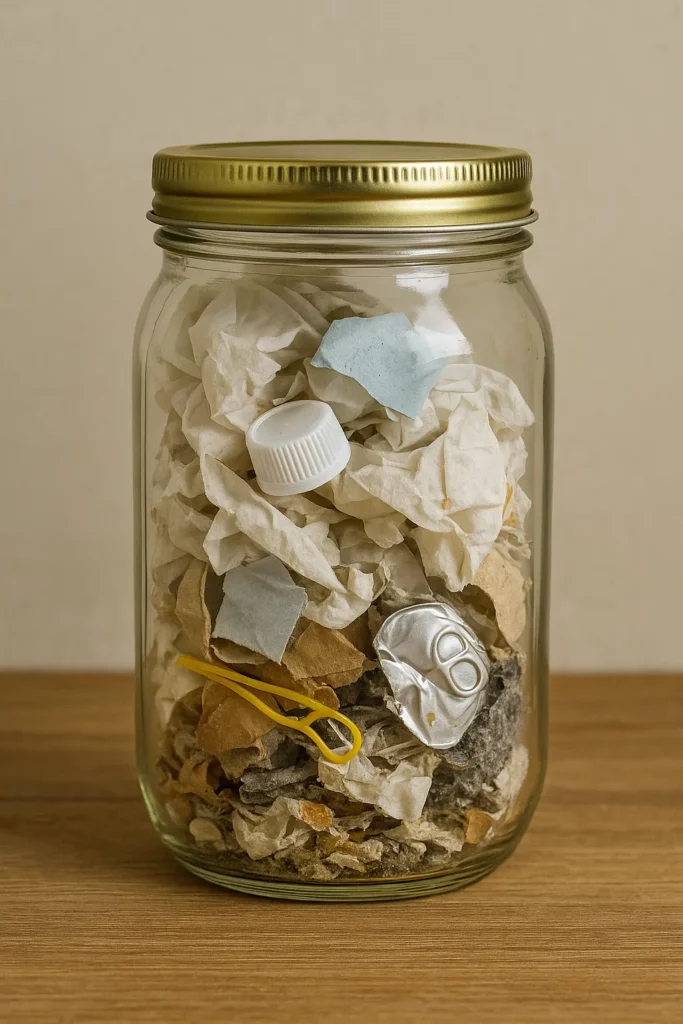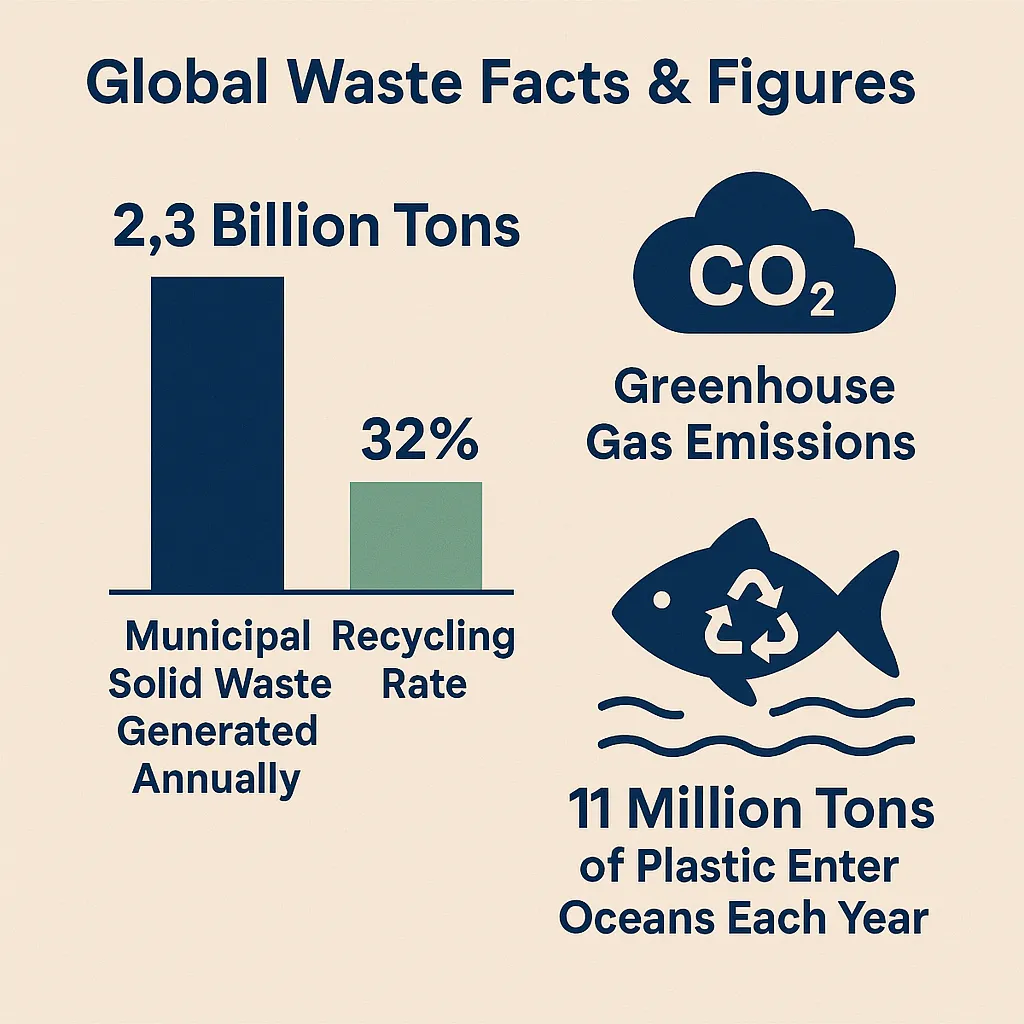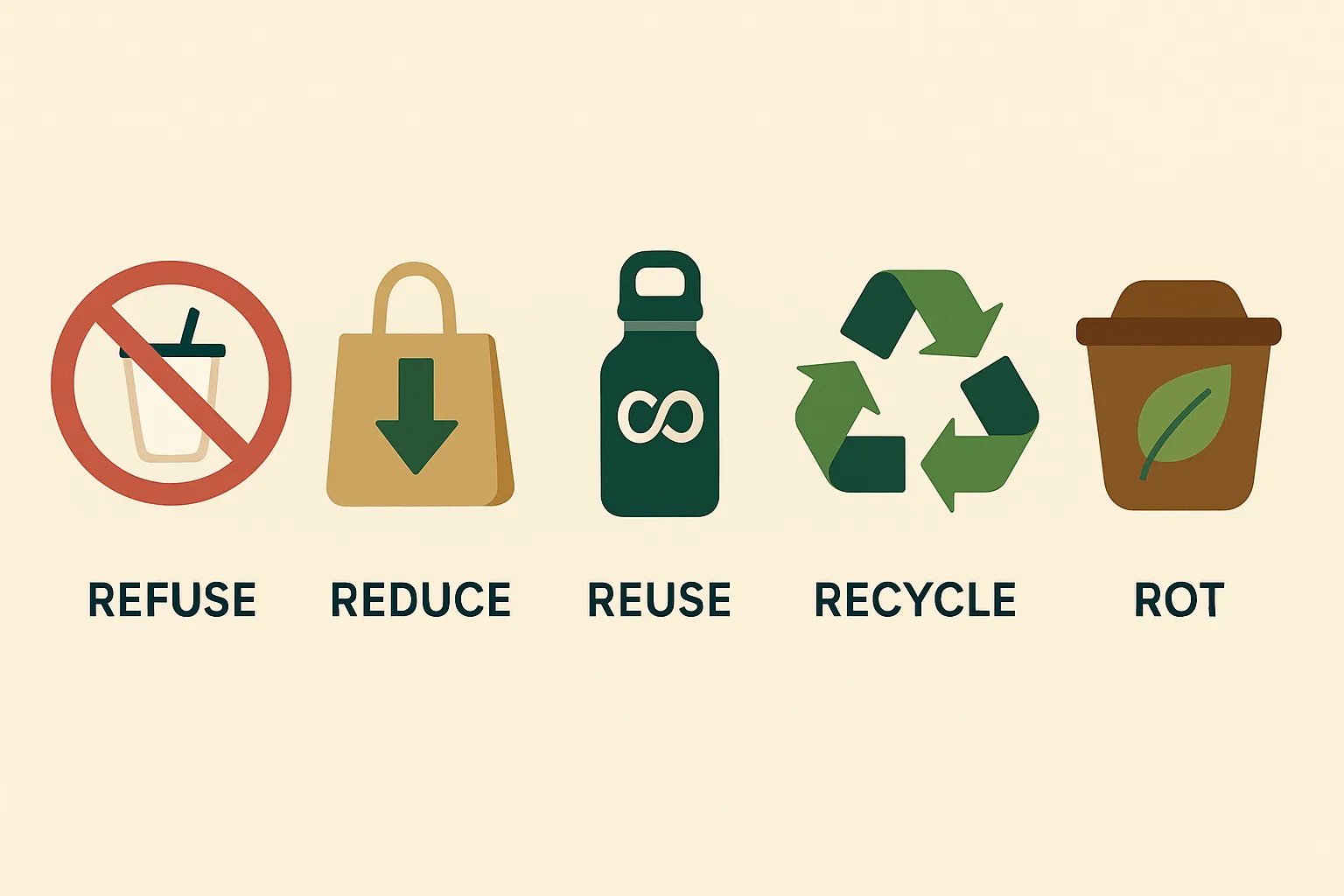Introduction
Zero waste living means making choices that cut down on as much trash as possible. It ties into sustainable living, minimalism, and the circular economy—ideas that help us use less, waste less, and reuse more. When you follow zero-waste principles, you think carefully about every product you buy, how long you’ll use it, and what happens when you don’t need it anymore.
Did You Know? The circular economy could reduce global carbon emissions by 9.3 billion tonnes by 2050 by keeping materials in use longer (Ellen MacArthur Foundation).
Table of Contents
1. What Is Zero-Waste—and Where Did It Start?

The term “zero waste living” might sound like aiming for perfection, but it’s really about making steady progress. Rather than burning or burying our trash in landfills and incinerators, zero-waste focuses on keeping materials in use for as long as possible. This slows resource depletion and cuts pollution.
Pro Tip: Start by tracking one type of waste (like plastic bottles) for a week. It’s easier to tackle a single habit first.
1.1 Bea Johnson’s Breakthrough
In 2009, Bea Johnson published Zero Waste Home and stunned the world by showing that her family of four produced just one quart (about 1 L) of trash over a full year. She documented clever swaps—like using cloth produce bags instead of plastic ones and making cleaning supplies from baking soda and vinegar—and practical steps anyone could follow. Her story spread through blogs, talks, and social media, inspiring millions to try reducing their waste.
Expert Quote:
“Zero-waste is not about perfection; it’s a commitment to continuous improvement.”
— Lauren Singer, founder of Trash Is for Tossers
1.2 The Zero Waste International Alliance (ZWIA)
Founded in 2008, the ZWIA provides definitions, guidelines, and certifications for zero-waste organizations, businesses, and communities. Their official hierarchy—Refuse, Reduce, Reuse, Recycle, Recover—helps groups measure progress and ensures consistency worldwide (ZWIA).
2. Global Waste Facts & Figures

Understanding the scale of the waste issue shows why zero-waste habits are urgent.
Did You Know? The world generated over 2 billion metric tons of municipal solid waste in 2018, enough to fill 800,000 Olympic swimming pools. That’s 0.74 kg per person per day on average (World Bank).
- Growing Waste Volumes: Projections estimate annual global waste could exceed 3.4 billion tons by 2050 without changes (World Bank).
- Landfill Emissions: Methane from landfills is 25× more potent than CO₂, driving climate change (IPCC AR6).
- Ocean Plastic Pollution: Around 8 million metric tons of plastic enter the oceans annually, endangering marine life and human health (UNEP).
- Recycling Rates Vary: Globally, only about 9% of plastic is recycled; most ends up in landfills or nature (OECD).
- E-Waste Explosion: Electronic waste reached 50 million tons per year in 2021, containing both valuable materials and toxic substances (Global E-waste Monitor 2022).
By seeing these numbers, we realize that small individual actions—like refusing a plastic straw—add up when millions of people join in.
3. Key Benefits of Zero-Waste Living
Adopting zero-waste habits brings many wins: for the planet, for your wallet, and for your well-being.
3.1 Environmental Benefits
- Lower Carbon Footprint: Fewer single-use products and less shipping reduce greenhouse gas emissions.
- Reduced Plastic Pollution: Each piece of avoided plastic keeps wildlife safer and waterways cleaner.
- Less Landfill & Incineration: Diverting organic waste to compost prevents methane release and toxic ash from incinerators.
Pro Tip: Carry a small stash of reusable utensils in your bag so you never have to accept single-use plastic cutlery.
3.2 Economic Benefits
- Household Savings: Bulk purchases often cost 20–30% less per unit than pre-packaged alternatives.
- Green Job Growth: The circular economy supports 3× more jobs per ton of waste than landfills or incineration (EPA).
3.3 Health & Well-Being
- Fewer Toxins at Home: Glass, stainless steel, and natural textiles don’t leach harmful chemicals like BPA or phthalates.
- Mindful Consumption: Zero-waste encourages you to buy fewer, higher-quality items—reducing stress and clutter.
3.4 Social & Community Advantages
- Community Building: Swap meets, tool libraries, and repair cafés bring neighbors together.
- Equity & Access: Sliding-scale pricing at refill stations ensures sustainable options for all income levels.
4. The 5 Rs: A Blueprint for Zero-Waste

Zero-waste living is guided by five core principles—order matters:
- Refuse
- Say “no thanks” to single-use plastic and freebies you won’t use.
- Reduce
- Cut back on purchases: borrow books from the library, skip impulse buys.
- Reuse
- Repair, upcycle, or donate items instead of discarding them.
- Recycle
- Follow local guidelines and rinse/sort materials properly.
- Rot (Compost)
- Turn food scraps and yard waste into nutrient-rich soil.
Waste Audit: For one week, save all your trash. At week’s end, sort it into “Refuse/Reduce/Reuse/Recycle/Rot” and spot your biggest improvement areas.
5. Tools & Innovations to Help You
Technology and new business models make zero-waste living more convenient.
5.1 Apps & Digital Resources
- JouleBug tracks sustainable habits.
- ShareWaste connects you with local composters.
- Good On You rates fashion brands on their ethical and environmental practices.
Did You Know? Using a barcode-scanner app can reveal hidden plastic packaging in everyday products.
5.2 Bulk-Buy Platforms & Refill Stations
- The Refill Shoppe (online) and local zero-waste stores let you bring containers to refill staples—grains, oils, cleaning products.
- Zero-Waste Pop-Ups: Temporary markets where unpackaged goods and DIY workshops appear.
5.3 Sustainable Materials & Certifications
- Bioplastics: Made from plants like corn or sugarcane; require proper composting conditions.
- Cradle-to-Cradle Certified: Products designed for reuse, repair, or safe composting (Cradle to Cradle).
6. Policy & Community Actions
Large-scale change happens when individuals, businesses, and governments work together.
6.1 Extended Producer Responsibility (EPR)
Makes manufacturers responsible for end-of-life collection and recycling of their products and packaging, shifting costs and design incentives back to producers (EU EPR Directive).
6.2 Plastic Bans & Fees
- Plastic Bag Fees/Bans: Many regions report a 50–90% drop in bag use after implementing fees or bans (NPR).
- Straw & Cutlery Bans: Encouraging alternatives like paper or metal reusables.
6.3 International Initiatives
- International Day of Zero Waste (March 30) unites global actions—from beach clean-ups to educational webinars.
- Pay-As-You-Throw (PAYT): Households pay for waste collection based on the amount discarded, incentivizing reuse, recycling, and composting.
6.4 Community-Led Successes
- San Francisco, USA: Diverts over 80% of its waste through mandatory recycling and composting laws (SF Environment).
- Kamikatsu, Japan: Residents separate trash into 45 categories and aim for zero waste by 2025—already at an 80% recycling rate (Town of Kamikatsu).
7. Challenges, Criticisms & Success Stories
Learning from real experiences helps us tackle obstacles and stay motivated.
7.1 Common Challenges
- Accessibility & Cost: Bulk shops and quality reusables can be scarce or costly in some areas.
- Behavioral Gaps: The “rebound effect” can occur when people over-rely on recycling instead of reducing.
- Misleading Labels: “Biodegradable” products may not break down in home compost bins.
Pro Tip: Research local compost facilities—what breaks down in an industrial composter versus your backyard bin.
7.2 Criticisms & Lifecycle Trade-Offs
- A reusable cotton produce bag must be used 327 times to offset its higher production footprint compared to a single-use plastic bag (Environmental Science & Technology).
- Washing reusable items uses water and energy—optimize by doing full loads on eco-settings.
7.3 Inspiring Success Stories
- Bea Johnson’s Household: Near-zero waste by swapping paper towels for cloth, cooking zero-food-waste recipes, and gifting experiences instead of things.
- Loop (TerraCycle): Delivers products in durable containers—empties are collected, sanitized, and refilled. Partners include Nestlé and Procter & Gamble.
- Toronto Green Bins: Over 200,000 households compost food waste, diverting 200,000 tons/year—enough to fill 56 Olympic pools.
8. Getting Started: Your 3-Step Action Plan
No perfection needed—just pick one small habit and build from there.
- Conduct a Waste Audit (1 week)
- Save or photograph everything you throw away.
- Sort it into Refuse/Reduce/Reuse/Recycle/Rot to see which bins fill fastest.
- Set SMART Goals
- Specific: “I will refuse plastic straws at restaurants.”
- Measurable: “I will reduce my weekly trash by 25%.”
- Achievable: Start with your morning coffee cup—use a reusable mug daily.
- Relevant: Choose goals that fit your routine.
- Time-Bound: “I’ll hit this target by July 31.”
- Build Your Zero-Waste Toolkit
- Reusable Essentials: Water bottle, coffee mug, shopping bags, produce bags, cutlery set.
- Compost Setup: Small countertop bin with compostable liners or membership in a local compost program. See our step-by-step composting guide for tips on bins, bins maintenance, and troubleshooting.
- Refillable Containers: Glass jars for bulk buys, stainless-steel lunchbox, cloth snack bags.
- Waste-Tracking App or Sheet: Log your progress weekly.
9. FAQ: Zero-Waste Living Made Simple
Q1: Can I compost in an apartment?
Yes! Use a worm bin (vermicomposting) under your sink or drop off scraps at a community compost hub.
Q2: How do I find bulk refill stores near me?
Try apps like BulkLocator or search “zero-waste store [your city]” online.
Q3: What if my local recycling program is limited?
Focus on refusing, reducing, and reusing. Mail-back recycling programs exist for hard-to-recycle items (e.g., Terracycle).
Q4: Are bioplastics really better?
They can reduce fossil fuel use, but only if composted properly. Always check local facilities’ capabilities.
Conclusion!
Every choice, big or small, adds up. Start by refusing a plastic straw this week. Try “Plastic-Free July,” or bring your reusable mug to your favorite café. Share your progress on social media with #ZeroWasteJourney to inspire others.
Join a local zero-waste group, advocate for stronger recycling laws, or organize a neighborhood swap event. Together, our tiny steps lead to big change—toward a future where materials stay useful, communities thrive, and we pass on a healthier planet to the next generation.
Your zero-waste journey starts now. Take one small action today, and watch how your habits transform your life—and the world around you.
Kaleem,
greenlifehub.com

